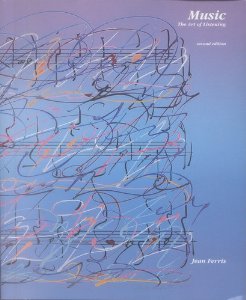
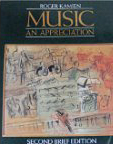
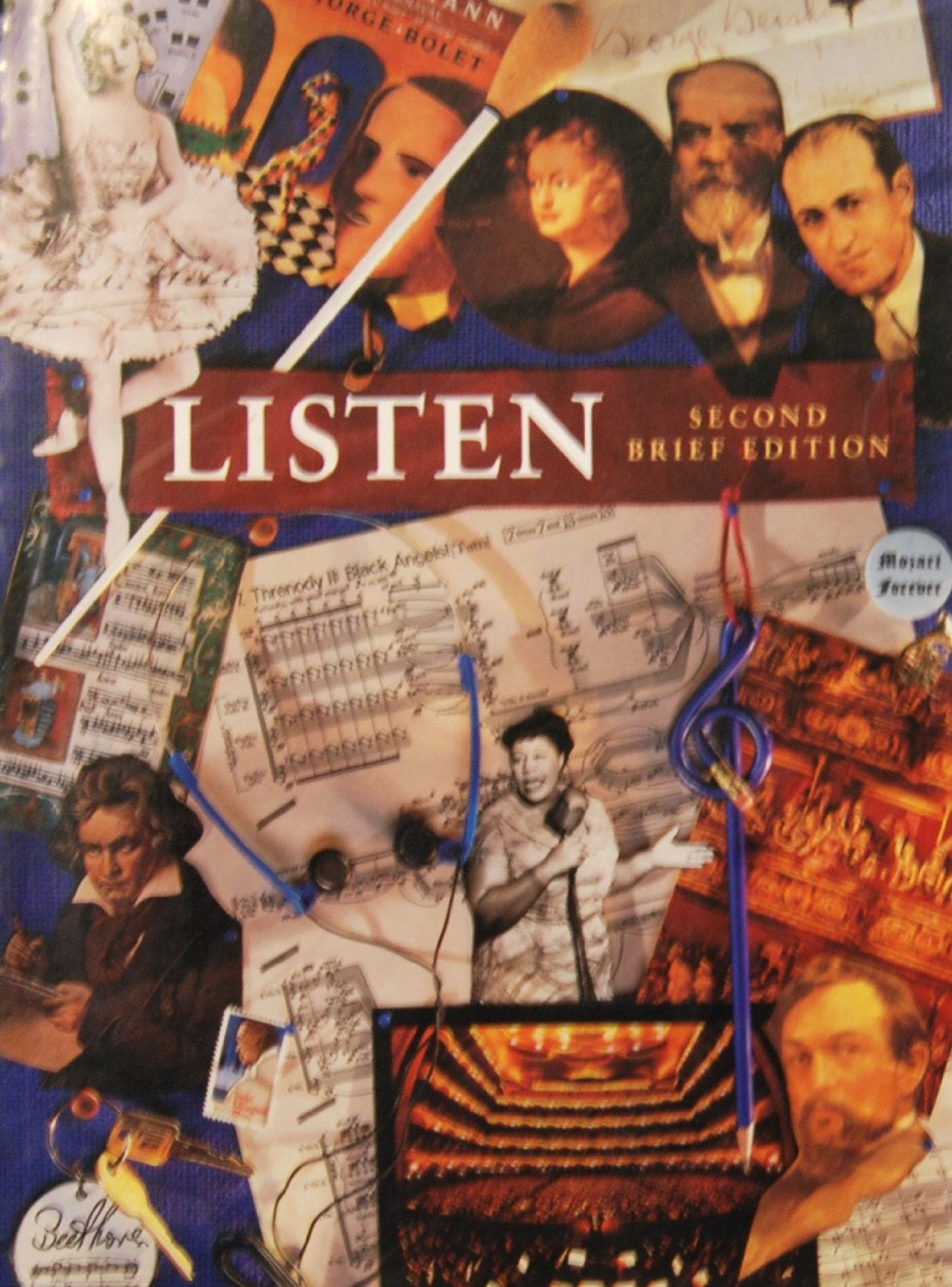
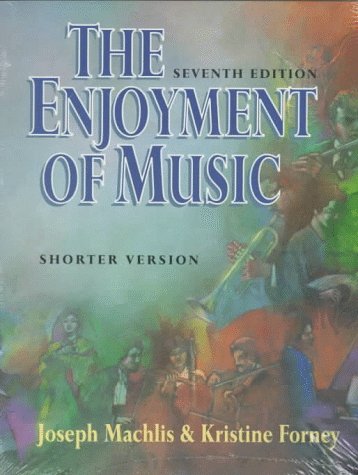
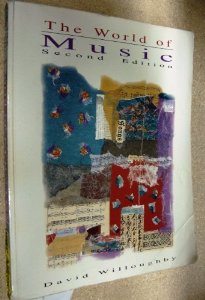 The Art of Listening to Music, by Jean Ferris. Madison, Wisconsin: Brown and Benchmark, 1995. 448 pp. ISBN 0-697-24544-6.
The Art of Listening to Music, by Jean Ferris. Madison, Wisconsin: Brown and Benchmark, 1995. 448 pp. ISBN 0-697-24544-6.
Music: An Appreciation, by Roger Kamien. New York: McGraw-Hill, 1994. xxv + 405 pp. ISBN 0-07-034819-7.
Listen, by Joseph Kerman. New York: Worth, 1996. xvii + 402 pp. ISBN 1-57259-058-0.
The Enjoyment of Music, by Joseph Machlis and Kristine Forney. New York: W. W. Norton, 1995. xxii + 515 pp. ISBN 0-393-96682-8.
The World of Music, by David Willoughby. Madison, Wisconsin: Brown and Benchmark, 1996. xv + 381 pp. ISBN 0-697-25838-6.
ISBNs are for book alone. All texts have separate ISBNs for the book with cassettes or with compact discs and choices as to the size of the accompanying recorded anthology.
Five textbooks are included in the discussion. Many other texts are available, and I do not mean to slight the efforts of other authors. The criteria for inclusion were as follows. Three texts were chosen because they are arguably the most popular: Kamien, Kerman, and Machlis/Forney. Statistics on actual adoption of music appreciation books are unavailable from publishers, but in this case longevity was substituted for actual sales figures. Copyright information on these books indicate that they were first published in 1976, 1972, and 1955, respectively. Two texts were chosen because of their strikingly novel approaches: Ferris and Willoughby.
Each of these books has packages of auxiliary support materials supplied by the publisher for the teacher's use, usually including additional recorded examples, test question banks, instructor resource manuals, and computer programs to aid in the navigation of musical examples. When substantial differences in these materials were found, they were noted. Prices of the materials to students have been omitted, as bookstores vary widely in their markup of academic materials. Most publishers offer both a three- and six-to-eight compact disc anthology. My experience has shown that both the scope and price of the three-recording sets are appropriate for use with students and that larger sets are used by teachers desiring supplemental material; therefore, comments regarding inclusion or exclusion of certain repertoires from the recorded anthologies are based on evaluation of the three-recording sets. All of the compact discs that accompany the selected texts have multiple track index points provided at places within each piece, usually at the beginning of sections or new themes. In addition to providing easier navigation for both student and teacher, multiple tracking may be effectively used in the listening guides included with the text and will be noted in the following discussion.
Common to all the texts is the philosophy that the value received from music is equal to the effort taken to understand and actively engage the listening experience. As Milton Babbitt stated (when referring to "difficult" modern music), "Like all communication,... music presupposes a suitably equipped receptor. . . . Why should the listener be other than bored and puzzled by what he is unable to understand, music or anything else?" All texts begin with sections building basic vocabulary and move to explanations of the historical context and musical features of examples from the recorded anthologies. Musical examples are accompanied by listening guides that aid the novice in hearing musical events, understanding foreign language texts, and that sometimes suggest questions to provoke critical thinking. All texts include samples of visual art from the periods and cultures covered, and all contain glossaries. At first glance, the similarities between the approaches can overshadow the differences. I will first discuss the nature of the differences encountered between the texts and follow with a discussion of the individual strengths and weaknesses of each text.
For example, while most texts generally agree on what music is (Kamien: an art based on the organization of sounds in time; Ferris: an art of organized sounds; and Kerman: the art of sound in time), Willoughby takes a more philosophical approach, suggesting three definitions and examining the limitations and advantages of each. For Willoughby, music may be "sound that is pleasing to the ear," "sound and silence organized in time," or "sound that you want to hear as music." Acceptance of each of these definitions creates for the listener a body of sound that is music and, by exclusion, a body of sound that is not music. All the texts challenge the listener to understand that some sounds are music and some are not, but only Willoughby encourages the listener to take responsibility for the decision.
One more example will suffice to illustrate the complexity of evaluating these texts. Program music is an important concept in the study of nineteenth-century music. All the texts offer definitions for program music along the lines of instrumental music associated with an extra-musical idea derived from a literary source (a poem or a story), an object of visual art, or other non-musical source (natural or man-made). Most authors suggest that composers use music to suggest moods or feelings and direct the listener's imagination by the use of a program. However, Kamien delves further into the ways in which music may suggest things, stating that "program compositions draw on music's capacity to suggest and evoke" and listing three ways that this evocation may occur: the imitation of natural sounds, correspondence between musical rhythm and objects in motion, and music's ability to create moods and emotions. Similarly, other examples could be drawn from each text to illustrate the areas in which a particular text excels, and it must be strongly emphasized that each text has its strengths. Perhaps the most useful way to compare these five texts and provide the appreciation teacher with useful information is to give a brief overview of the unique features of each.
Each section of the Kerman text is introduced by an in depth discussion of the era to be studied. Color and black and white reproductions of visual art appear throughout the textual discussion. Composer's biographies are confined to brief, informative sidebars, each concluded with a condensed list of important works. The list of recordings and page references on the inside cover and the page references in the glossary of terms are particularly useful. The easy-to-use Hypercard Stack (Macintosh only) includes a fundamentals tutorial, listening guides (with boxes that highlight to indicate which section is playing and additional sidebar information), a glossary, active listening quizzes, and a timeline. The main component of each chapter is a discussion of the listening examples, each handled as an example of an important genre. Kerman offers a wide variety of ways for the novice listener to access the music. An overview of each genre is followed by extensive program notes on each individual piece with interesting anecdotes, explanations of musical or formal elements, and descriptive prose, often referring to aesthetic qualities (such as, "a blend of melancholy and tranquillity shaken more than once by displays of deeper emotion"). After the description of each piece, a listening chart provides the listener with timings, references to track numbers, and descriptions of musical events contained in the piece (including notated examples). Music chosen for inclusion reflects the traditions of western Europe with a strong emphasis on the Baroque and Classical repertoire. Seventeen of the thirty-three pieces are by six composers: Vivaldi, Handel, Bach, Mozart, Haydn, and Beethoven. The author notes that discussion of music before 1600 may be omitted, and in fact, the three-compact disc set includes only one piece from that period. Although discussion of music composed by women is included in the text, only one example appears in the recorded anthology: Tania Len's Kabiosile (1988). The closing section of the text focuses on music in America, including a nicely rounded section on African-American music with seven well-chosen examples of jazz and jazz-related pieces. The single criticism that may be leveled at this section is the inclusion of works of Gershwin and Bernstein (both certainly worthy of inclusion) in preference over perhaps William Grant Still and/or other deserving Black composers.
Although the Machlis/Forney text is also organized as a genre study, composers' biographies preface the first example by each composer, and important works are included in the biographical discussion. Each era is introduced with a section highlighting the important social and political events of the time and outlining the concurrent musical innovations. Color and black and white reproductions of visual art are interspersed throughout the book. Recordings in the three-compact disc set are listed on the inside cover. Unique to the Machlis/Forney text is a cross-platform listening program (Macintosh and Wintel, distributed free to adopters and their students) that includes a fundamentals tutorial and listening guides. Found only in this program is a bar that actively scrolls along with the music, also allowing the operator to begin and pause the piece at any point in the music, not just at sectional breaks. While other programs provide the listener with feedback at the beginning of each new section, this program provides continuous information on the listener's location in the selection. The discussion of the listening examples is confined largely to formal and stylistic commentary with an occasional descriptive phrase ("bright, jovial . . . stamped with aristocratic refinement"). A brief description of each piece is followed by a listening chart providing the listener with timings, references to track numbers, and descriptions of musical events contained in the piece with notated examples of the important musical ideas. While the musical selections represent the western Europe art music tradition from the Baroque, Classical, Romantic, and twentieth-century eras nearly equally, eight examples are from before 1600. Discussion of music composed and performed by women is interspersed in the text, and three examples appear in the recorded anthology. A thread of discussion about American music runs throughout the text, and three jazz-related examples and a rock tune added at the end of the text illustrate one aspect of our American musical culture. The main criticism of this text is the cursory homage paid to world music, with the single example of South African mbube, and the tendency of the discussion of twentieth-century music to resort to a tedious listing of composers, each with a three-sentence description. Strong points are the informative sidebars on related topics (e.g., "Music and the American Religious Spirit," "Crossover and the Growing Musical Audience," and "Polish Folk Dance and Music") and the interspersing of the discussion of form at appropriate points in the text; for example, an explanation of sonata form prefaces the discussion of classical style.
Kamien organizes his discussion of music history as a succession of great men and women. Each era is preceded by a discussion of the stylistic elements that found acceptance during the period. Discussion of the social and political events are included secondarily, and only as they pertain to music. Black and white reproduction of art works are spread throughout the text, but the insertion of full color reproductions of works of visual art in sections on slightly heavier pages is a minor irritation as the book always opens to these pages. Each piece is prefaced by discussion of the details of its composition and a brief descriptive section. Additional notes concerning the use of historical instruments are included when appropriate. The pieces, track, and page references for the three-compact disc set are listed on the inside cover with a complete listing of the eight-compact disc set in the appendices. The definitions in the glossary contain references to specific examples in the recorded anthology, complete with compact disc, track, and timing. A Hypercard Stack (Macintosh only) provides illustration for the basic musical elements and active navigation within musical examples. As in the Kerman stack, labels indicating section breaks highlight when the section is reached, and information concerning the musical features of the section appears in a separate box. Here too discussion of the listening examples is primarily formal and stylistic commentary with an occasional descriptive phrase, but the author touches on aesthetic qualities as well ("The gentle opening movement blends lyricism with a touch of sadness owing to the many shifts between major and minor"). These listening charts also provide the listener with timings, references to track numbers, and descriptions of musical events contained in the piece with notated examples of the important musical ideas. The music included in Kamien is balanced evenly between the four post-1600-era-works with four examples before 1600. Brief sections at the end of the book highlighting the contributions of rock and jazz are not accompanied by musical examples of either genre. Unique to this book are the five introductory selections in the "Elements" section, which include one piece each by Wagner, Louis Armstrong, Bizet, Tchaikovsky, and Bach. Neither Kerman nor Machlis use this much music as an introduction, and the variety of Kamien's selections is refreshing. A short section at the end of the book provides musical vignettes of two world cultures: Angola and Japan. This section's usefulness is greatly increased over the rock and jazz sections by the illustration of each culture with a recorded example, but those with an interest in teaching a more inclusive course should read further.
The Ferris text takes the genre approach with ample introduction of political, religious, and social history before the discussion of each era. The color reproductions of visual art are separated into sections without the problems encountered in the Kamien text. The feature setting this text apart from the first three texts reviewed is the inclusion of examples of a wide variety of world musics and cultures as well as discussion of American music. Ferris skillfully announces her intention to students with her second example from the "Basic Concepts" section, Scott Joplin's "Maple Leaf Rag." Six "Musical Encounters" are interspersed at various junctures in the historical study of western European art music and include music of India, Northern Africa (Islamic), China, Native America, Japan, and West Africa. Highlights of musical life in America are integrated with discussion of European music although no musical examples are provided; and while several topics concerning the musical contributions of women are covered, only one recorded example is included: Amy Beach's "The Year's at the Spring." The listing of musical selections in the text after the table of contents sometimes contains information regarding the performer(s) of the selection. Although each selection contains several tracks, the text makes no reference to the individual tracks within a selection. Each musical example is discussed in general terms in the text and in detail in a listening example box. The material in the box varies from example to example, containing a minimum of information about the composer/performer (for world examples) and a program-note style explanation of salient features. No timings or track references are included in the guide, but other topics may include details such as key, meter, tempo, form, and text. Each chapter concludes with questions to stimulate critical thinking, a list of terms studied in the chapter with their definitions, key composers, optional listening examples (additional listening guides are provided in the instructor packet), and suggestions for further listening.
Willoughby's The World of Music represents the most individual approach discussed so far in this review. The author's stated goal is to "discuss the roots and development of a variety of musical styles having the greatest impact on American society." Although the text begins with a discussion of the elements of music, this occupies only eleven pages (not including the seven-page introduction considering philosophical issues associated with music making and perception), with an additional eight pages filled with discussions of listening examples using concepts introduced in the section. This is approximately one third to one half of the length of comparable sections in the other four texts reviewed. The inclusiveness of Willoughby's musical choices can be seen in a partial listing of the non-European selections: African-American folk song, Anglo-American folk song, Black gospel music, jazz, country swing, 1950s rock and roll, soul, new age, Native American dance music, Mexican folk song, mariachi music, reggae, klezmer, North Indian gat, and African mbira. After surveying American and world music cultures, Willoughby manages to include a large amount of European art music. The extent of his coverage can be seen in his seventeen compositions chosen from this tradition: six are by the Baroque and Classical composers mentioned above (see Kerman), two by Americans, and three by women. Each chapter begins with a barebones outline of the chapter and a list of the musical examples and concludes with a summary and list of important terms and concepts. Words included in the glossary appear in boldface in the text. Listening guides include the performers' credits, a short (one or two sentence) summary of the important points illustrated by the example, a list of goals for listening, and a guide to important musical sections and themes. Each example closes with a list of critical thinking questions or "reflections," as Willoughby calls them. Although the compact discs contain multiple tracks for each selection, they are not referred to in the discussions of the examples.
Through the process of examining these texts, several issues have become clear to me. At the outset, I perceived that these five books had an apparent unity of purpose and somewhat similar approach to achieving the desired results: active listening which produces a greater understanding of the musical process. At the end of this critical investigation, I must conclude that each of these five authors (or groups of authors) has taken years of experience from the classroom and translated it into a method that works for him or her. Which one works for you depends on many things: your desired inclusivity of repertoire; the proportions of aesthetic, descriptive, and formal considerations with which you are comfortable; the amount of time that you wish to spend on critical thinking issues; and the method that you choose for classroom presentation and use of computer technology. Additionally, at least five times the number of textbooks reviewed are currently on the market, and at least half of those would have been worthy of consideration. My purpose is not to suggest that you adopt a specific text; rather, I hope I have raised issues that will be useful in evaluating the texts in which you are interested.


